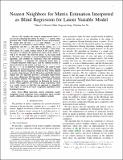Nearest Neighbors for Matrix Estimation Interpreted as Blind Regression for Latent Variable Model
Author(s)
Li, Yihua; Shah, Devavrat; Song, Dogyoon; Yu, Christina Lee
DownloadAccepted version (1.722Mb)
Open Access Policy
Open Access Policy
Creative Commons Attribution-Noncommercial-Share Alike
Terms of use
Metadata
Show full item recordAbstract
© 1963-2012 IEEE. We consider the setup of nonparametric blind regression for estimating the entries of a large {m} \times {n} matrix, when provided with a small, random fraction of noisy measurements. We assume that all rows {u} \in [{m}] and columns {i} \in [{n}] of the matrix are associated to latent features {x}_{\text {row}}({{u}}) and {x}_{\text {col}}({{i}}) respectively, and the ({\it{ u, i}})-Th entry of the matrix, {A}({\it{ u, i}}) is equal to {f}({x}_{\text {row}}({{u}}), {x}_{\text {col}}({{i}})) for a latent function f. Given noisy observations of a small, random subset of the matrix entries, our goal is to estimate the unobserved entries of the matrix as well as to 'de-noise' the observed entries. As the main result of this work, we introduce a nearest-neighbor-based estimation algorithm, and establish its consistency when the underlying latent function f is Lipschitz, the underlying latent space is a bounded diameter Polish space, and the random fraction of observed entries in the matrix is at least \max \big ({m}^{-1 + \delta }, {n}^{-1/2 + \delta } \big) , for any \delta > 0. As an important byproduct, our analysis sheds light into the performance of the classical collaborative filtering algorithm for matrix completion, which has been widely utilized in practice. Experiments with the MovieLens and Netflix datasets suggest that our algorithm provides a principled improvement over basic collaborative filtering and is competitive with matrix factorization methods. Our algorithm has a natural extension to the setting of tensor completion via flattening the tensor to matrix. When applied to the setting of image in-painting, which is a 3-order tensor, we find that our approach is competitive with respect to state-of-Art tensor completion algorithms across benchmark images.
Date issued
2020Department
Massachusetts Institute of Technology. Laboratory for Information and Decision Systems; Massachusetts Institute of Technology. Department of Electrical Engineering and Computer Science; Statistics and Data Science Center (Massachusetts Institute of Technology)Journal
IEEE Transactions on Information Theory
Publisher
Institute of Electrical and Electronics Engineers (IEEE)